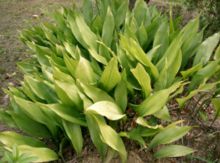Aspidistra
| Aspidistra | |
|---|---|
 |
|
| Aspidistra elatior | |
| Scientific classification | |
| Kingdom: | Plantae |
| Clade: | Angiosperms |
| Clade: | Monocots |
| Order: | Asparagales |
| Family: | Asparagaceae |
| Subfamily: | Nolinoideae |
| Genus: |
Aspidistra Ker Gawl. |
| Synonyms | |
|
|
Aspidistra /ˌæspᵻˈdɪstrə/ is a genus of flowering plants in the family Asparagaceae, subfamily Nolinoideae, native to eastern and southeastern Asia, particularly China and Vietnam. They grow in shade under trees and shrubs. Their leaves arise more or less directly from ground level, where their flowers also appear. The number of species known has increased considerably from the 1980s onwards, with around 100 accepted as of July 2013[update]. Aspidistra elatior is common worldwide as a foliage house plant that is very tolerant of neglect. It and other species can also be grown in shade outside, where they are generally hardy to −5 °C (23 °F).
Species of Aspidistra are perennial herbaceous plants growing from rhizomes. The leaves are either solitary or are grouped in small "tufts" of two to four. They arise more or less directly from the rhizome, rather than being borne on stems. Each leaf has a long stalk (petiole) and a blade with many veins. The flowering stem (scape) is usually very short so that the flowers appear low down among the leaves. The fleshy flowers are bell-, urn- or cup-shaped. They vary considerably in size and shape, although few are showy. The flowers of A. longipedunculata are yellow and, unusually for the genus, are borne on scapes up to 20 cm (8 in) high. A. grandiflora has spider-like flowers up to 12 cm (5 in) across. The flower has a large stigma with a flattened top. The fruit is a berry, often with a single seed.
...
Wikipedia
